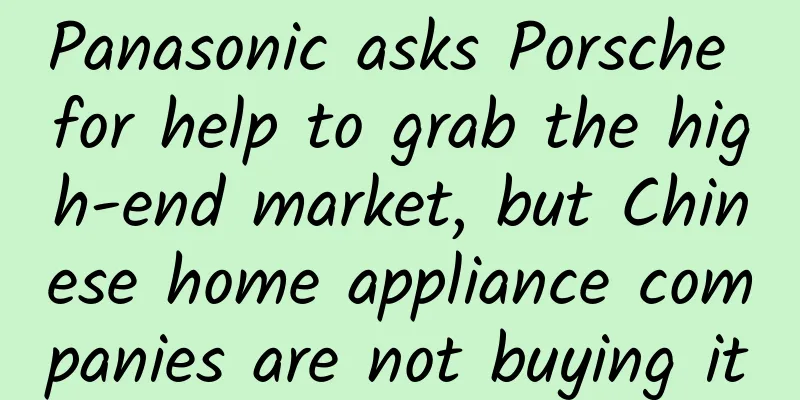Panasonic asks Porsche for help to grab the high-end market, but Chinese home appliance companies are not buying it

|
The biggest puzzlement of a group of foreign brands represented by Panasonic in the Chinese home appliance market is that in the face of the high-end consumer market that has already exploded and is growing, foreign giants with strong brand and product power have not grabbed the biggest piece of the pie. And the subsequent situation shows that once the high-end market is lost, foreign companies will have no way out. Recently, a cooperation between two foreign-funded enterprises in Berlin, Germany, has caused some splashes in the Chinese home appliance market. The protagonists of the event are Panasonic, a long-established Japanese home appliance company, and Porsche, a high-end German automobile company. The two companies hope to establish Panasonic's high-end washing machine image in the Chinese market and grab a share of the high-end market through all-round cooperation. However, Panasonic, which has accelerated its transformation to B2B business, has been losing ground in the global home appliance market over the past five years, giving the outside world the impression that "Panasonic has simply given up on the pace of the white goods retail market." However, as Panasonic's operating profits in fiscal 2016 mainly came from the automotive and white goods businesses, its efforts to promote B2B business were either small in scale, low in profit, or slow in progress. Since the second half of last year, Panasonic has suddenly increased its investment in the layout and market expansion of white goods retail businesses such as washing machines, refrigerators, and air conditioners. Therefore, in the Chinese market, Panasonic established a company called Panasonic AP China this year to integrate all of Panasonic's previously scattered home appliance businesses in China. It attempts to change the past "each doing its own thing" situation, where the company was strong but not big, and hopes that through "cooperative operations" it can help Panasonic white goods seize the rising high-end consumer business opportunities in China in the future. At the same time, it will build another growth point outside of Japan. At present, Panasonic's confidence in reviving its white goods business comes from the good results it has achieved in the Japanese white goods market over the past year and a half, with "increased volume and increased profits", and the strong rigid demand in the white goods market; on the other hand, it is due to the rising trend of high-end and high-quality consumption in China, which makes Panasonic, which has a good brand reputation, think that the opportunity has come. Therefore, Panasonic's white goods business will first seek a rebound and revival in Japan, China, Southeast Asia and other Asian regions. However, the challenges and variables that Panasonic has not faced are: First, in the past two years, Panasonic's white goods business in the Japanese domestic market has been revived, mainly due to the business opportunities given up by traditional strong competitors such as Toshiba and Sharp due to losses and sales. With the integration and recovery of the latter, Panasonic's future development in the Japanese white goods market will inevitably usher in a fierce battle. Second, it is an indisputable fact that Panasonic has seen the rise of high-end consumption in China's white appliance market, which has brought business opportunities and space. However, it is not just Panasonic that has seen the Chinese high-end home appliance market. Other Chinese and foreign peers are actively competing and laying out their positions, and their advantages are obvious. Now, in addition to the brand, what other differentiated advantages does Panasonic have? Not obvious. In fact, in order to welcome the 100th anniversary of its founding in 2018, Panasonic has adopted a series of measures to turn losses into profits after Kazuhiro Tsuga became president, and has undergone multiple transformations and adjustments to its business objectives in the past few years. What is most well-known is that Panasonic has made a leap from B2C to B2B by relying on its own technological innovation, products, and system solution capabilities. At the same time, it has drastically reduced layoffs and cut back on non-core businesses, such as selling off and shrinking black appliances and white appliances in the consumer market. It has made great efforts to promote the breakthrough of complete solutions to the commercial market. However, last year Panasonic adjusted its original revenue target of 10 trillion yen by 2018, the centenary of its founding, to 8.8 trillion yen. At the same time, facing the B2B business that has been promoted and implemented for many years, it has not been able to achieve growth in scale and profit, so it has to shift its focus to the two areas of automotive and white goods, which have obvious relative advantages, hoping to achieve a "single-soldier breakthrough" business strategy. In this context, the revival and rebound of Panasonic's white goods business is only a short-term strategy. Against the backdrop of the company's broad prospects for B2B business, the white goods business with low profits and fierce competition will eventually withdraw from Panasonic's strategic core. Next, whether Panasonic's white appliance business can achieve greater success in the above three strategic markets is unclear in the home appliance industry. However, we do know that it will be difficult for Panasonic to make a difference in China's high-end white appliance market. The problem is not that Panasonic's products have no characteristics or its brand has no texture, but its bloated organizational structure, slow operating efficiency, and lack of proactive response capabilities. It is difficult to proactively respond in terms of interaction and experience with users. In essence, it is still a terminal shelf in the high-end home appliance market. In fact, in recent months, the integration of Panasonic AP China's home appliance business and the resulting synergy effect have not been obvious, and progress has been quite slow. The situation of each of the air conditioner, refrigerator and washing machine still exists. It can be said that for such a century-old enterprise, any organizational change and business transformation is not so easy. As a winner of Toutiao's Qingyun Plan and Baijiahao's Bai+ Plan, the 2019 Baidu Digital Author of the Year, the Baijiahao's Most Popular Author in the Technology Field, the 2019 Sogou Technology and Culture Author, and the 2021 Baijiahao Quarterly Influential Creator, he has won many awards, including the 2013 Sohu Best Industry Media Person, the 2015 China New Media Entrepreneurship Competition Beijing Third Place, the 2015 Guangmang Experience Award, the 2015 China New Media Entrepreneurship Competition Finals Third Place, and the 2018 Baidu Dynamic Annual Powerful Celebrity. |
<<: Ford will recall more than 950,000 vehicles worldwide due to Takata airbags
>>: Tesla CEO Musk: China has become the global leader in electric vehicle applications
Recommend
Arbor Day丨Can towering trees really "reach the sky"? How tall can trees really grow?
It is said that "ancient trees are towering&...
Taobao customer promotion, traffic diversion and fission techniques!
As we all know, there are flash sale groups and c...
95% of fans have lost contact, and the editor feels like they have been heartbroken? How to awaken dormant fans through operation
The number of fans is increasing, but the number ...
Can “not eating after noon” help you lose weight? A year-long experiment found…
Reviewer of this article: Chen Haixu, Deputy Dire...
How does Baidu bidding charge? Is there any contact information?
Baidu’s paid promotion is charged based on clicks...
Although electrolyte water has benefits, don’t drink it as water!
Recently, following canned yellow peaches, electr...
4000-word KOC expert operation strategy
This article wants to talk about KOL/ KOC communi...
American TV series "Friends" all 10 seasons in high definition English with Chinese subtitles
Friends is an American television sitcom created ...
Is there an inevitable connection between deafness and dumbness? How can we protect our ears scientifically?
The importance of hearing is self-evident. This y...
How do big self-media accounts make money?
The fans of emotional self-media are ordinary peo...
The most complete and detailed APP promotion channels and planning schemes in history
For a successful application, developing the APP ...
Kuaishou and Douyin are becoming "Taobao-like": from traffic distribution to demand distribution!
With the strategic upgrades of major platforms an...
How to send lucky bags on Douyin? What is a Super Lucky Bag?
Today I will introduce to you the content about D...
String theory in the garden
How to quantize gravity is a puzzle for theoretic...
How does Pinduoduo operate? Detailed analysis of Pinduoduo’s operations!
1 Merchant promotion path 1.1 Beginner's Guid...









